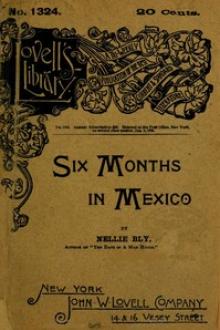Six Months in Mexico by Nellie Bly (best classic literature TXT) 📕

- Author: Nellie Bly
- Performer: -
Book online «Six Months in Mexico by Nellie Bly (best classic literature TXT) 📕». Author Nellie Bly
At several places we found things for sale which looked like dahlias, with a strange mixture of colors. None could determine just what they were, but presently we found a man and woman manufacturing them. They were nothing more or less than long radishes, which with his penknife the man turned into all kinds of flowers, as well as crosses and other designs. The woman delicately touched one part one color, another another, until they formed one of the most beautiful of the many strange sights on La Viga. There was quite a rush for them, and the happy purchasers triumphantly carried them off, while the less fortunate looked on with regret. I got a number, but before the next morning their beauty had departed forever, and their perfume was loud and unmistakable. Of course there were plenty of venders and beggars there. The venders had wax figures representing ballet dancers, rope-walkers, angels - any sort of female that was skimp in her wearing apparel. Others had men fighting bulls, monkeys on horseback, baby dolls made of rags, and every little thing which could be invented.
This feast lasted until Sunday evening, and there was not a moment from three o’clock Friday morning, until twelve o’clock Sunday night, but what the place was crowded worse than Barnum’s show in its brightest days. The prettiest sight was when the people returned to town. Every carriage, even to the driver’s seat, was filled with flowers. The horses and riders were decorated with wreaths, and in this manner they all returned to their homes. I must describe one rider to you before I leave La Viga. He rode a beautiful black horse. The Mexican saddle was a bright, deep yellow, covered with silver ornaments, and a bright sword dangled at the side. The bridle was entirely of silver, even to the reins, and silver cord and tassels decorated the horse’s neck. The rider’s pants were black and fitted as if he had been poured into them. A row of silver buttons, at least the size of pie-plates, reached from waist to knee, where they were met by high side-buttoned boots. An immense silver spur completed that part. His vest was yellow velvet, his coat blue, and his wide sombrero red, all heavily trimmed with silver, while at the back, peeping beneath his coat, were two mammoth revolvers. He was the most gorgeous butterfly I ever saw, and attracted attention from Mexicans as well as myself.
Sunday was observed by the churches as well as on La Viga. It was Palm Sunday, and the Indians had made pretty things out of dry palms which they sold to the people for from a real (twelve and one half cents) up to cinco pesos ($5). The devout took these to church and had them blessed, and after carrying them home they were fixed to the bars of windows, the balconies and above the doors, where they will stay for the whole year. They say they keep the devil out, and that is their reason for using them.
Excursion trains were run in from all the connecting points, people appeared in the most gorgeous hues, and venders had no trouble in selling the effigies they carried. Holy Thursday came and the bells tolled from early morning until ten o’clock, when every one was silent in sorrow for the crucifixion. Mass was said in the morning, and all turned out to attend divine service. In the Alameda, Zocola and paseo bands, to the number of three or four, delighted their hearers. It seemed rather strange to stand within the church door and hear the voice of the priest repeating mass, the piano playing a soft prelude (no pipe organs are permitted during holy week), and the band mingling the lively strains of some light opera, or something equally ridiculous, with this solemn service, The altars were all hung with squares of silver or gold tinsel, which were constantly in motion. Thousands of candles lighted up the gloomy building, and Christ and the Virgin were the only images in sight. At 3 o’clock in the afternoon they brought in what they said were the oldest and most neglected of beggars. The priest washed their feet, and after making the sign of the cross with holy oil upon them, they were allowed to depart. I noticed these men’s feet had been washed recently, and also that there were dirtier and poorer people in the audience. However, the washer took good care not to touch the feet without an intervening towel. At night the churches were brilliantly illuminated. It would be hard to give an estimate of the candles required, but I fully believe that in some of the big edifices 20,000 would not be a bad guess. The devout were all on their knees, and everything was as silent as death, except the piano, which still kept up its soft, soothing melody.
On Good Friday all the men and women were dressed in black, and every church was draped with purple. The Virgin was dressed in heavy black velvet. The poor Indians laid flowers, money and candles around the image, and they could not have been more deeply touched had the crucifixion taken place then instead of so many hundred years ago. They kissed her feet, her garments, and the floor before her, and showed in a thousand humble ways their love and devotion.
The ceremony of the Tres Horas (three hours) was celebrated in Texcoco. First a lot of masked men ran around the yard with sticks, beating the bushes, trees and flowers as though in search of something. Then one of the men who was far from representing Christ in form, feature or complexion, took a heavy wooden cross on his shoulders and walked into the church, being lashed with a leather strap by the masked men. When he fell the people covered their faces and groaned. He fell three times before reaching the altar, where an effigy was nailed to the cross. The sounds of the hammer and groans and cries of the people made one feel as if somebody had dropped a piece of ice down their back. Finally, amid the most heartrending cries, the cross was raised and the ceremony was over.
All day wagons, horses, boxes, everything in the toy line, with a racket in them, were sold to the people. All the venders were located around the cathedral and Zocolo, and the din could be heard several squares away. These are called matracas. When Christ was on earth, they say, they had no bells with which to call the people to mass, so these matracas were made, and a number of men would promenade the streets, swinging them around to keep up the incessant cracking. The men would cry out, “The hour has come for mass, the hour has come for mass,” and the faithful would hurry away to count their beads and say their prayers. A foreigner told me this custom was still in vogue in some parts of his country, France, during holy week. Hideous effigies, called Judas, were for sale. Little ones made of lead were bought and tied to the button-hole, the parasol, the bracelet, the belt, or any other convenient place. Some made of plaster of Paris and paper, from three inches to twelve feet long, were bought by old and young and carried home for Saturday.
Sabado de Gloria (Saturday of Glory) came bright and sunny. All along the streets were strung long Judases, some having pasted on them the thirty pieces of silver for which he betrayed Christ; the image was made in the most horrible form - as a negro, devil, monkey, half beast, half human, every form that could possibly be thought of. At 11 o’clock the bells began to ring merrily, as though rejoicing over the fate of Judas, and a match was applied to every image in the town; they were all filled with powder, and with one accord there was a universal bursting and tearing and rejoicing throughout the city. As fervent as had been their devotion to the Virgin, just as strong was their hatred of Judas - even the smallest scraps they tramped upon.
By 12 o’clock gay colors were resumed, carriages which had been rigorously kept out of sight came forth and were flying down the paseo as if glad that the time of quietness was past. All places of amusement, which had been closed during Lent, began sticking up posters announcing a grand opening on the next (Sunday) evening. The noise of the matracas grew fainter and fainter, and gradually ceased. The wind picked up the stray pieces of Judases, played with them awhile, and then carried them out of sight. The venders who had jammed the Zocalo gradually disappeared, the music in the different parks ceased, and Lent seemed as far gone, by the time 12 o’clock rang forth, as though six months had passed. Such is life.
On Sunday the theaters, bull-fights, circus and race-courses were well attended. The bull-fights were advertised as the last of the season. The one I attended was excellent. The bulls were good ones, and some very new and striking features were introduced. One man sat down on a chair in the center of the ring with two banderillias in his hand. The door was opened, and the bull rushed in and at him. He sat there, and as it put down its head to gore him he stuck the banderillias into its neck and sprung aside, while the bull knocked the chair into atoms. Everybody cheered, and threw the fellow money and cigars. After this toro had been dispatched, one man lay down on the ground and another stood over him, keeping his head between his legs. Again they opened the door and let a toro in. It rushed for the men, but the one standing stuck the banderillias into it with such force that it roared with pain and took after one of the other fighters in the ring, leaving the two men unhurt. The very daring of this delighted the people, for if the man had missed the bull both of them would have been killed without the least trouble.
One toro had horns about four feet wide, and at the first plunge it killed one horse. Then it caught another horse and threw it on its back, the rider underneath. The fighters tried to draw it off, but it stayed there until the horse was dead. All that could be seen of the rider was his head, which he tried vainly to shield with his arms. They carried him off for dead. This toro was very hard to kill. It required seven lunges of the sword to convert him into beef. One toro refused to fight, and when stuck with a sharp pica he jumped over the fence and was with the audience. Such a scrambling! Most of the people threw themselves into the ring, about the first ones to go being the guards, who are placed around to take care of the people. It was quite a while before quiet was restored, and the toro lassoed and removed.
Bull-fights have lasted longer this season than ever before, as it is impossible to fight during the rainy season.





Comments (0)